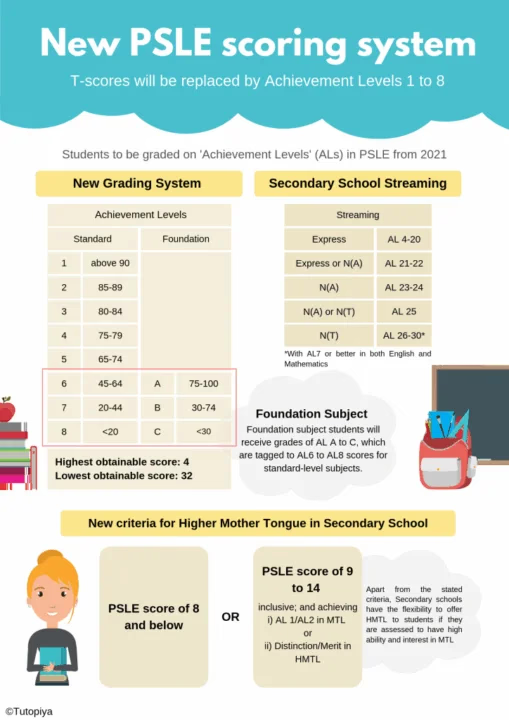
The NEW PSLE Scoring system 2021: All You Need To Know
It’s no old news that the PSLE scoring system of the PSLE Curriculum will be changing this year 2021. The change was announced several years ago and it will be implemented this year. This article will take you through the changes made to the scoring system.
The scoring system will affect some aspects of the academic scoring for secondary schools and they include
- The overall scoring
- Streaming
- Subject Based Band
- Higher Mother Tongue
What is the new PSLE scoring system 2021?
The overall scoring system
Students will be graded by Achievement Levels also known as AL. The range of marks for their respective ALs are as follows:
| AL | Reference Raw Mark Range |
|---|---|
| 1 | ≥ 90 |
| 2 | 85-89 |
| 3 | 80-84 |
| 4 | 75-79 |
| 5 | 65-74 |
| 6 | 45-64 |
| 7 | 20-44 |
| 8 | <20 |
Students from the foundation stream will also follow the new scoring system but with a little difference:
| Achievement Level | Foundation Raw Mark Range | Equivalent Standard Achievement Level |
|---|---|---|
| A | 75-100 | 6 |
| B | 30-74 | 7 |
| C | <30 | 8 |

You can also visit MOE’s official website to find out more about the scoring system.
Secondary 1 Posting
Students will still be streamed into Express, Normal (Academic) and Normal (Technical) for their secondary schools.
Under the new PSLE scoring system, the proportion of students qualifying for the different streams is expected to be broadly similar.
| Streaming Outcomes | PSLE Score (ALs) |
|---|---|
| Express | 4-20 |
| Express/N(A) option | 21-22 |
| N(A) | 23-24 |
| N(A)/N(T) Option | 25 |
| N(T) | 26-30 with AL 7 or better in both English Language and Mathematics |
Students will still be able to have six choices when it comes to selecting their secondary school and will be posted based on their academic results.
In the event that students with the same PSLE score are vying for the last place in school, there are several tie-breakers that will be used and they are as follows:
- Citizenship
- Where a Singapore Citizen will be admitted ahead of a Singapore Permanent Resident
- Choice of the order of schools
- Computerized balloting
Subject-Based Banding (Secondary) SBB
The Subject-Based Banding was introduced to allow students to be able to take various subjects at a more advanced level at Secondary 1 based on their subject-specific strengths and aptitudes.
With the new PSLE scoring system, the SBB scheme continues to provide for the students but with a new grading system following the AL scoring system.
| PSLE Standard / Foundation subject grade | Option to take a subject at |
|---|---|
| AL 5 or better | Express Level |
| AL 6 or better / AL A | N(A) Level |
As students continue to progress in secondary school, they will be offered further opportunities to take higher level subjects if they demonstrate competencies and aptitude.
Higher Mother Tongue
The new scoring system allows students to take Higher Mother Tongue if they an
- An overall PSLE score of 8 or better; or
- An overall PSLE score of 9 to 14 (inclusive); and attain AL 1/ AL 2 in MTL or distinction/ merit in HMTL
For students who admit to the secondary school without meeting the above requirements, secondary schools will have the flexibility to offer HTML if they are assessed to have high ability, competencies and interest in MTL.
The purpose of the New PSLE scoring system
The Ministry of Education’s initiatives to alter the PSLE scoring system is part of their efforts to shift away from the over-emphasis on academic achievement and results.
The PSLE scores are now less differentiated with only 29 possible PSLE scores compared to the old PSLE scoring system with more than 200 possible aggregates.
With broader Cut Off Points, students will be able to have a wider range of selection of their secondary schools.
Even with the changes made to the PSLE scoring system, it can still be difficult to find the right school moving forward.
Read also: How to Choose the Right Secondary School After PSLE
Written by
Tutopiya Team
Educational Expert
Related Articles

When should you start talking to your child about financial management?
Learn essential financial management skills for children with practical tips and activities. Empower your kids with money management knowledge for a brighter future!

Guide to choosing the best online tuition app
Find the best online tuition app for IGCSE, IB, & A-levels. Discover key features & choose wisely for your child's international education success.

7 Tips for Finding a Suitable Math Tutor For Your Child in Singapore
Comprehensive guide and expert insights on educational topics for IGCSE, IB, and international curriculum students.
